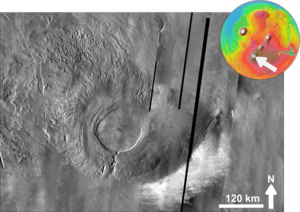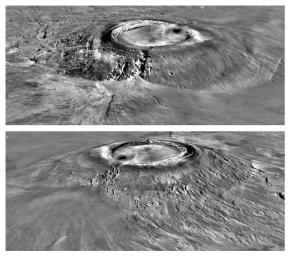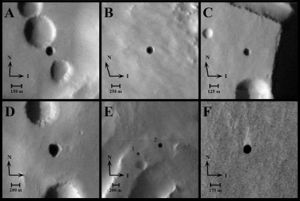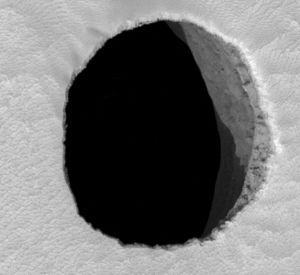Difference between revisions of "Arsia Mons"
m |
|||
| Line 1: | Line 1: | ||
| + | |||
| + | {{Mars atlas}} | ||
'''Arsia Mons''' is an extinct [[shield volcano|shield]] [[volcano]] in the [[Tharsis]] region near the equator. It is part of the [[Tharsis Montes]] group of volcanos. Its location is 8.35 S and 120.09 W (239.91 E) in the Phoenicis Lacus quadrangle. Its name is a classical feature name and comes from a corresponding albedo feature on a map by Giovanni Schiaparelli, which he named in turn after the legendary Roman forest of Arsia Silva.<ref>https://planetarynames.wr.usgs.gov/Page/MARS/target</ref> Researchers have found much evidence for glaciers on Arsia Mons.<ref>Scanlon, K., J. Head, D. Marchant. 2015. REMNANT BURIED ICE IN THE ARSIA MONS FAN-SHAPED DEPOSIT, MARS. 46th Lunar and Planetary Science Conference. 2266.pdf</ref> | '''Arsia Mons''' is an extinct [[shield volcano|shield]] [[volcano]] in the [[Tharsis]] region near the equator. It is part of the [[Tharsis Montes]] group of volcanos. Its location is 8.35 S and 120.09 W (239.91 E) in the Phoenicis Lacus quadrangle. Its name is a classical feature name and comes from a corresponding albedo feature on a map by Giovanni Schiaparelli, which he named in turn after the legendary Roman forest of Arsia Silva.<ref>https://planetarynames.wr.usgs.gov/Page/MARS/target</ref> Researchers have found much evidence for glaciers on Arsia Mons.<ref>Scanlon, K., J. Head, D. Marchant. 2015. REMNANT BURIED ICE IN THE ARSIA MONS FAN-SHAPED DEPOSIT, MARS. 46th Lunar and Planetary Science Conference. 2266.pdf</ref> | ||
<ref name="ReferenceA">{{cite journal | last1= Shean | first1= David E. | last2= Head | first2= James W. | last3= Fastook | first3= James L. | last4= Marchant | first4= David R. | title= Recent glaciation at high elevations on Arsia Mons, Mars: Implications for the formation and evolution of large tropical mountain glaciers| page= E03004 | date= 2007 | issue= E3 | volume= 112 | doi = 10.1029/2006JE002761 | journal= Journal of Geophysical Research | url=http://www.planetary.brown.edu/pdfs/3281.pdf | format = PDF | }}</ref> | <ref name="ReferenceA">{{cite journal | last1= Shean | first1= David E. | last2= Head | first2= James W. | last3= Fastook | first3= James L. | last4= Marchant | first4= David R. | title= Recent glaciation at high elevations on Arsia Mons, Mars: Implications for the formation and evolution of large tropical mountain glaciers| page= E03004 | date= 2007 | issue= E3 | volume= 112 | doi = 10.1029/2006JE002761 | journal= Journal of Geophysical Research | url=http://www.planetary.brown.edu/pdfs/3281.pdf | format = PDF | }}</ref> | ||
Latest revision as of 17:50, 8 January 2020
Arsia Mons is an extinct shield volcano in the Tharsis region near the equator. It is part of the Tharsis Montes group of volcanos. Its location is 8.35 S and 120.09 W (239.91 E) in the Phoenicis Lacus quadrangle. Its name is a classical feature name and comes from a corresponding albedo feature on a map by Giovanni Schiaparelli, which he named in turn after the legendary Roman forest of Arsia Silva.[1] Researchers have found much evidence for glaciers on Arsia Mons.[2] [3]
Caves
Seven cave entrances have been discovered on the sides of Arsia Mons. These caves could contain reserves of water ice or even life. They are possible locations for a cave settlement. With the low gravity of Mars, lava tubes may be over 800 feet in width. A lava tube on Mars could protect colonists from meteorites and radiation. Because of the lack of a magnetic field at present, Mars has a fair amount of radiation, especially from cosmic ray sources.[4] A mini-series produced by National Geographic in 2016 depicted how people could establish a base in a cave.[5] [6]
Clouds
Repeated Clouds over Arsia Mons [7] there is some debate about the nature of the clouds whether they are dust particles or water vapor [8] If this is in fact Water Vapor, that indicates the presence of Water Ice around Arsia Mons. [9] [10]
References:
- ↑ https://planetarynames.wr.usgs.gov/Page/MARS/target
- ↑ Scanlon, K., J. Head, D. Marchant. 2015. REMNANT BURIED ICE IN THE ARSIA MONS FAN-SHAPED DEPOSIT, MARS. 46th Lunar and Planetary Science Conference. 2266.pdf
- ↑ "Recent glaciation at high elevations on Arsia Mons, Mars: Implications for the formation and evolution of large tropical mountain glaciers" (PDF) (2007). Journal of Geophysical Research 112 (E3). doi:.
- ↑ https://www.sciencedaily.com/releases/2017/09/170925112842.htm
- ↑ https://www.nationalgeographic.org/education/mars
- ↑ https://www.leonarddavid.com/underground-caves-on-moon-mars-protected-habitats-for-explorers/
- ↑ Jet Propulshion Lab, California Institute of Technology Repeated Clouds over Arsia Mons , https://www.jpl.nasa.gov/spaceimages/details.php?id=PIA04294
- ↑ THEMIS: Ice-rich clouds over Arsia Mons’ caldera, ASU, R Burnham THEMIS: Ice-rich clouds over Arsia Mons’ caldera , http://redplanet.asu.edu/?p=30885, Sep 2018.
- ↑ 43rd Lunar and Planetary Science Conference, USRA - Universities Space Research Association VOLCANO-ICE INTERACTIONS RECORDED IN THE ARSIA MONS FAN-SHAPED GLACIAL DEPOSITS , https://www.lpi.usra.edu/meetings/lpsc2012/pdf/2183.pdf, 2012.
- ↑ LAPL HIRISE, Kelly Kolb, University of Arizona Glacier-Like Flow on Arsia Mons Flank , https://www.uahirise.org/PSP_002922_1725, 4 April 2007.
| This article is a stub. You can help Marspedia by expanding it. |











